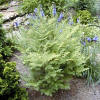|
HOME
Frog Gallery
Family Genealogy
Favorite Recipes
Gardening Articles by Karin
Rainfall in Marietta
Cat Pix
Sons of the American Revolution
Sope Creek Garden Club
Favorite Links
| | | Known as Atlantic White Cedar, this native conifer has to be among my favorites.
There are many selections available, predicted to have a variety of heights. This would be my choice over the
ubiquitous Leyland Cypress. The growth habit is similar, although somewhat slower. They appreciate dampness,
occurring naturally in swampy areas, but also seem to thrive in ordinary garden conditions. They are my first
choice for planting wet areas, have the formality that some beds require and yet fit naturally in nearly any landscape.
For versatility, the Chamaecyparis thyoides are my first choice.
Be aware that a species Chamaecyparis thyoides can
grow to 40-50 ft. high, also a lovely tree in the right place, but be
careful when you shop!
Click on thumbnails for larger images. |
| Chamaecyparis thyoides 'Little Jamie'
Predicted size: 4.5 ft. x 18
inches
'Little Jamie' apparently had too many vitamins.
It was predicted to be only 2 feet tall, but it has now grown to about 4.5
feet tall and about 18" wide. It is the upright conifer to the right in the
photo below. You can see that it's growth habit is the same as it's
cousin 'Meth Dwarf', but quite different, so far, from the weaker 'Shiva'. It
grows in a difficult spot, close to hot pavement on two sides, in full sun.
'Jamie' has not complained. |
|
Sentries - 'Meth Dwarf' to the left
 'Little Jamie' to the right.
'Little Jamie' to the right. both
recommended by Adrian Bloom |
| Chamaecyparis thyoides 'Meth Dwarf'
Predicted size: 5 ft. x 18 inches
'Meth Dwarf' stands to the left in the above photo,
indicating a bridge crossing of a small stream that wanders through the
conifer garden. Predicted to be only 5 feet tall and 18 inches wide, it seems
to have reached it mature size. It has multiple trunks, but does not splay out
in heavy rain or snow. Both are planted in slightly amended soil in full
sun. |
| Chamaecyparis thyoides 'Shiva'
There is a lot of discussion about whether or not
this is a thyoides. Researching online indicates that some are convinced it
is although I have been unable to locate a definitive answer. Appearances can certainly be misleading. |
 |
Unlike
it's cousins in my garden, this plant had a hard time getting established and
appeared to have died, but returned from the dead and has did quite well
through a wet summer. The droughty years almost did it in. Now
that it is more mature, it withstood an extremely dry, hot summer in
2006, planted in only slightly amended soil and full sun. |
|

